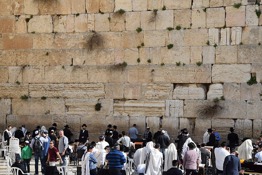Hakhel

On the mitzvah of hakhel, which takes place during the Sukkot following the shemitah year. How do we remember this mitzvah today? Chapter 29 of the Consumer's Guide to Shemitah.
- The mitzvah of hakhel does not apply today, as the Beit Hamikdash has not yet been rebuilt and we cannot hold the ceremony in the courtyard (azarah) of the Beit Hamikdash.[1]
- The accepted practice is to perform a ceremony in memory of the mitzvah on the second[2] day of chol hamo'ed Sukkot on the year following shemitah. [3]
- At the outset of yom tov, Torah scholars should study the Torah portion in the written Torah (Devarim 31) and the oral Torah (Sotah 41). The next day, a platform should be set up by the Western Wall and the entire nation should attend. Torah giants should teach the nation Torah and speak about topics that inspire the nation to draw closer to G-d.[4]
- "This is a mitzvah that is a strong pillar and great honor for the religion."[5] In the merit of the yearning for Zion, there will be a balm for our afflictions.[6]
[1] The mitzvah of hakhel appears in Devarim 31:10–13; Mishnah, Sotah 7:8; Rambam, Hilchot Chagigah, ch. 3; Sefer Hachinuch, mitzvah 612.
With regard to the biblical obligation, some maintain that it depends on shemitah, which today is not a biblical obligation: Aderet, Kuntress Zecher Lamikdash, Warsaw 5649, reprinted in Sefer Hakhel, published by Torah VeHa'aretz Institute, 5761, p. 495; Rabbi Herzog, "Zecher Lehakhel" (printed in Sefer Hakhel, p. 618). However, Rabbi Shlomo David Kahana, "Hakehel bazeman hazeh" (ibid., p. 549) deliberates whether the mitzvah of hakhel also applies today, suggesting it might be biblical. On the reason that the mitzvah of hakhel does not apply today (even miderabanan), Minchat Chinuch writes (mitzvah 612) based on Sotah 41b, that the mitzvah is contingent on the Temple courtyard standing. However, he notes that further study is necessary. This is also the opinion of Aderet (Zecher Lamikdash, ibid.) and Rabbi Avraham Shapira (Sefer Hakhel, p.558) that it is possible that the obligation of hakhel depends on the mitzvah of re'iyah ("making an appearance" before G-d when making the pilgrimage to the Temple during the three festivals: Sukkot, Pesach, and Shavu'ot); this mitzvah, in turn, is contingent on the existence of the Beit Hamikdash. Furthermore, hakhel could the condition of "bevo kol Yisra'el;" that is, when the majority of the Jewish People live in the Land of Israel. It is possible that in the times of the Second Beit Hamikdash this mitzvah applied miderabanan. However, in the absence of a Beit Hamikdash, there is no obligation whatsoever.
[2] While technically hakhel should take place on the first day of chol hamo'ed, practically it is observed on the second day of chol hamo'ed. This allows those who observe a second day of yom tov to join. The ceremony is generally performed in the afternoon, several hours after the major birkat kohanim (priestly blessing) ceremony in the morning.
[3] For a historical survey of all of the years following shemitah from 5636 to 5755, see Sefer Hakhel, p. 653. This is the opinion of the great posekim of the past generations, including the chief rabbis of Israel: Aderet (ibid.); Rabbi Herzog (ibid.); Rabbi Tzvi Yehuda Kook; and Rabbi Avraham Shapira, ibid. See also Rabbi Zevin, Le'or Hahalachah, p. 135. For the opinions of those opposed to holding this ceremony today, see Sefer Hakhel, p. 676.
[4] Rabbi Herzog, ibid.
For all the laws of Hakhel, see articles in Sefer Hakhel 5706, reprinted in 5733, and Sefer Hakhel 5761. In 5776 (2015, following the previous shemitah year), tens of thousands attended the event, led by the chief rabbis of Israel and Jerusalem, with the participation of leading rabbis and public officials. The event included reading chapters of Tehillim by Israel's president (Reuven Rivlin).
[5] Sefer Hachinuch, end of mitzvah 612.
[6] See Chiddushei Chatam Sofer, Sukkah 41a.




